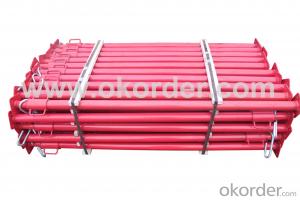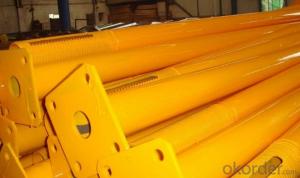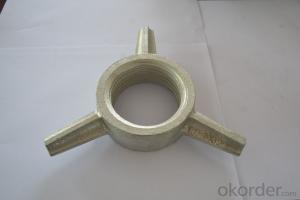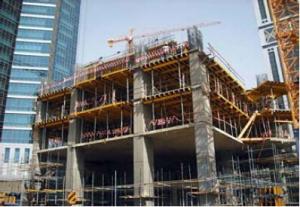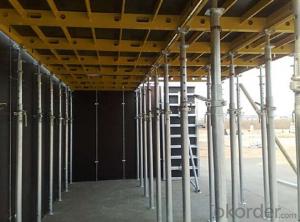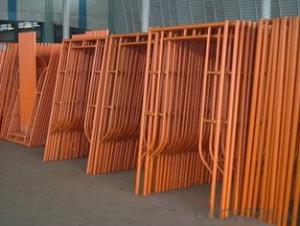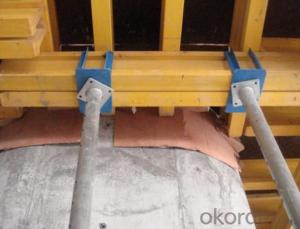U Head Scaffolding Steel Prop
- Loading Port:
- China Main Port
- Payment Terms:
- TT OR LC
- Min Order Qty:
- -
- Supply Capability:
- -
OKorder Service Pledge
OKorder Financial Service
You Might Also Like
Quick Details
| Brand Name: | Finish: |
Packaging & Delivery
| Packaging Detail: | Pallet |
| Delivery Detail: | within one month |
Specifications
Ringlock System
1. Vertical,Ledger,Transom,Diagonal Brace,Base Jack
2. EG, Dip Painting,HDG
3. Pallet Package
4.Q235,Q345
Ringlock System
1. Vertical,Ledger,Transom,Diagonal Brace,Base Jack
2. EG, Dip Painting,HDG
3. Pallet Package
4.Q235,Q345
Ringlock Scaffolding
Widely welcome around the world
Ringlock System is composed by Standard, Transom, Ledger;Diagonal Braces, board,etc...
We have a capability of 1000 Metric tons per month
We can supply Dip Painting Surface, HDG Surface and EG Surface
| Ringlock component | Specification (mm) | Weigtht (kg) | Material |
| Standards with Spigot | 500 | 3.09 | Q235/Q345 |
| 1000 | 5.49 | ||
| 1500 | 7.90 | ||
| 2000 | 10.30 | ||
| 3000 | 15.11 | ||
| 3500 | 17.51 | ||
| Ledgers | 750 | 3.20 | Q235 |
| 1000 | 4.07 | ||
| 1065 | 4.31 | ||
| 1200 | 4.78 | ||
| 1500 | 5.88 | ||
| 2000 | 7.56 | ||
| 2200 | 8.30 | ||
| 2500 | 9.35 | ||
| 3000 | 11.13 | ||
| Ladder | 3000 | 17.80 | Q235 |
| Braces | 750x2000 | 9.18 | Q235 |
| 1000x2000 | 9.47 | ||
| 1500x2000 | 10.31 | ||
| 2000x2000 | 11.40 | ||
| 2500x2000 | 12.67 | ||
| 3000x2000 | 14.06 |
Type of shoring props:
Shoring entails the construction of a temporary safety structure to prop up walls in a building that has become unstable due either to foundational expansion or natural disaster. The type of shoring a contractor chooses will depend on a specific building's structural status and the circumstances surrounding the building's weakness.
- Q:What are the common maintenance tasks for steel props?
- Common maintenance tasks for steel props include regular cleaning and inspection, lubrication of moving parts, and addressing any signs of damage or wear. Regular cleaning is essential to keep steel props in good condition. This involves removing dirt, dust, and debris from the surface of the props. This can be done using a soft cloth or brush and a mild detergent or cleaning solution. It is important to avoid using abrasive materials or harsh chemicals that can damage the steel. Inspection is another important maintenance task for steel props. This should be done regularly to identify any signs of damage or wear. Inspecting for rust, cracks, or bent parts is crucial to ensure the safety and functionality of the props. If any issues are identified, the props should be repaired or replaced as necessary. Lubrication is necessary for the moving parts of steel props. This includes hinges and joints that may need to be lubricated to ensure smooth operation. Using a suitable lubricant, such as oil or grease, will help prevent friction and maintain the performance of the props. In addition to these tasks, it is important to follow the manufacturer's guidelines for maintenance and care. This may include specific instructions for cleaning, lubrication, and storage. Adhering to these guidelines will help prolong the lifespan of the steel props and ensure their safe and efficient use.
- Q:What are the common methods of adjusting the height of steel props?
- The common methods of adjusting the height of steel props include using a threaded collar, a pin and slot mechanism, or a telescopic design where the inner tube slides into the outer tube to achieve the desired height.
- Q:Can steel props be used for supporting temporary sports facilities?
- Temporary sports facilities can indeed benefit from the use of steel props for support. In construction and temporary structures, steel props are frequently employed to offer stability and support. Their strength and durability make them highly suitable for various types of structures, including temporary sports facilities. Whether it involves setting up temporary bleachers, tents, or other sports-related structures, steel props guarantee stability and ensure the facility's safety. Moreover, steel props possess the advantage of being easily adjustable in height and capable of withstanding heavy loads. Their versatility and ability to support temporary sports facilities make them an ideal choice.
- Q:Can steel props be used in supporting temporary formwork systems?
- Yes, steel props can be used in supporting temporary formwork systems. Steel props are commonly used to provide temporary support and stability to formwork during construction. They are adjustable in height and can withstand heavy loads, making them suitable for supporting temporary formwork systems.
- Q:Can steel props be used for supporting walls during demolition?
- Yes, steel props can be used for supporting walls during demolition. Steel props, also known as adjustable steel props or acrow props, are widely used in construction and demolition projects to provide temporary support to walls, beams, and ceilings. They are adjustable in height, allowing them to be customized to the required length for supporting walls of varying heights. Steel props are known for their high load-bearing capacity and stability, making them a reliable choice for supporting walls during the demolition process. Their sturdy construction and ability to withstand heavy loads ensure that they can effectively support walls and prevent any collapse or damage during the demolition process. Additionally, steel props are easy to install and remove, making them a convenient and efficient solution for supporting walls during demolition.
- Q:Can steel props be used in the construction of theme parks?
- Yes, steel props can certainly be used in the construction of theme parks. Steel is a widely used material in the construction industry due to its strength, durability, and versatility. Steel props provide excellent support and stability, making them ideal for constructing various structures within theme parks, such as roller coasters, water slides, and other large-scale attractions. Steel props can withstand heavy loads and extreme weather conditions, ensuring the safety and reliability of the theme park structures. Additionally, steel is a sustainable material that can be recycled, making it an environmentally friendly choice for construction projects. Overall, steel props are a popular choice in the construction of theme parks due to their strength, durability, and ability to create impressive and exciting attractions for visitors.
- Q:Can steel props be used for temporary support in railway platform construction?
- Steel props are indeed suitable for temporary support in the construction of railway platforms. They are widely employed in construction endeavors to furnish temporary support for various structures, including the building of railway platforms. These props possess adjustability, allowing them to be extended or retracted as required to provide the vital support and stability. Typically crafted from high-strength steel, they exhibit the necessary robustness to endure the weight and load demands of railway platforms. Moreover, steel props can be swiftly and effortlessly installed and removed, rendering them a pragmatic option for temporary support during railway platform construction.
- Q:What are the different materials used for steel props?
- The different materials used for steel props typically include high-quality steel alloys, such as carbon steel or stainless steel. These materials are chosen for their strength, durability, and resistance to corrosion, making them suitable for supporting heavy loads and withstanding harsh environmental conditions.
- Q:Are steel props suitable for supporting mezzanine floors?
- Yes, steel props are suitable for supporting mezzanine floors. Steel props are strong, durable, and adjustable, making them an ideal choice for providing stable support to mezzanine floors. They can easily bear the weight of the additional floor and ensure its structural integrity.
- Q:What are the safety considerations when using steel props?
- When utilizing steel props, there are several safety factors that must be taken into account. To begin with, it is imperative to thoroughly inspect the steel props before each use. This entails examining for any indications of damage, such as cracks, bends, or corrosion. If any damage is detected, the props should be promptly replaced to prevent any potential accidents or failures. Furthermore, it is of utmost importance to ensure that the steel props are appropriately sized and adjusted to support the intended load. Utilizing props that are either too short or improperly adjusted can result in instability and collapse, thereby posing a significant safety hazard. It is advisable to adhere to the manufacturer's guidelines and consult with a structural engineer if necessary. Additionally, it is crucial to securely fasten the steel props to prevent any movement or displacement. This can be accomplished by employing suitable base plates or wedges and confirming that the props are firmly secured to the structure they are providing support to. Regular checks should be conducted to ensure that the props remain in place throughout their usage duration. Moreover, it is essential to take into consideration the surrounding environment when employing steel props. This includes evaluating the ground conditions, such as soil stability and load-bearing capacity, to ensure that the props are adequately supported. If required, additional measures, such as shoring or bracing, may need to be implemented to enhance stability and prevent any potential accidents. Lastly, it is crucial to provide proper training and supervision to all personnel involved in the utilization of steel props. They should be educated on the correct procedures for installation, adjustment, and removal of the props, as well as the potential risks and hazards associated with their use. Sufficient personal protective equipment (PPE) should also be provided to ensure the safety of the workers. Overall, by adhering to these safety considerations, the risk of accidents or failures when employing steel props can be significantly mitigated, thereby creating a safer working environment for everyone involved.
1. Manufacturer Overview |
|
|---|---|
| Location | |
| Year Established | |
| Annual Output Value | |
| Main Markets | |
| Company Certifications | |
2. Manufacturer Certificates |
|
|---|---|
| a) Certification Name | |
| Range | |
| Reference | |
| Validity Period | |
3. Manufacturer Capability |
|
|---|---|
| a)Trade Capacity | |
| Nearest Port | |
| Export Percentage | |
| No.of Employees in Trade Department | |
| Language Spoken: | |
| b)Factory Information | |
| Factory Size: | |
| No. of Production Lines | |
| Contract Manufacturing | |
| Product Price Range | |
Send your message to us
U Head Scaffolding Steel Prop
- Loading Port:
- China Main Port
- Payment Terms:
- TT OR LC
- Min Order Qty:
- -
- Supply Capability:
- -
OKorder Service Pledge
OKorder Financial Service
Similar products
New products
Hot products
Related keywords



